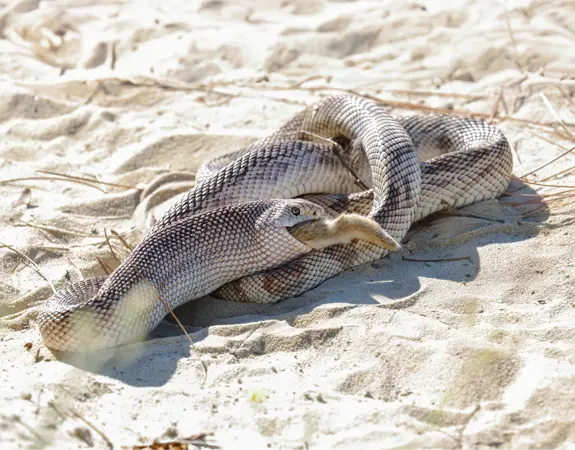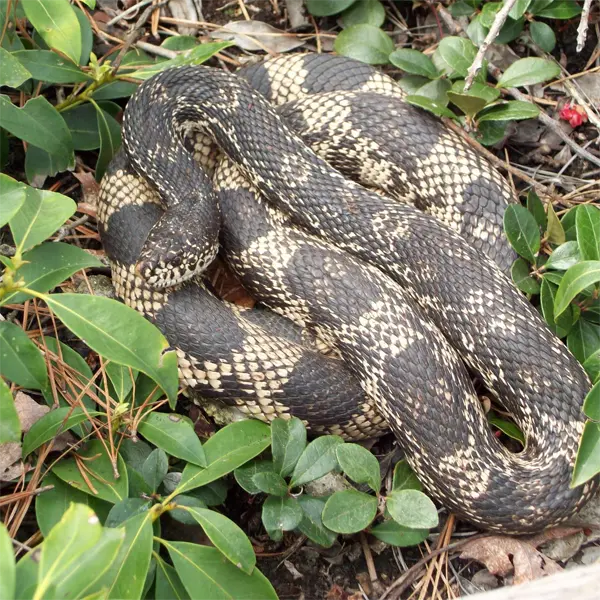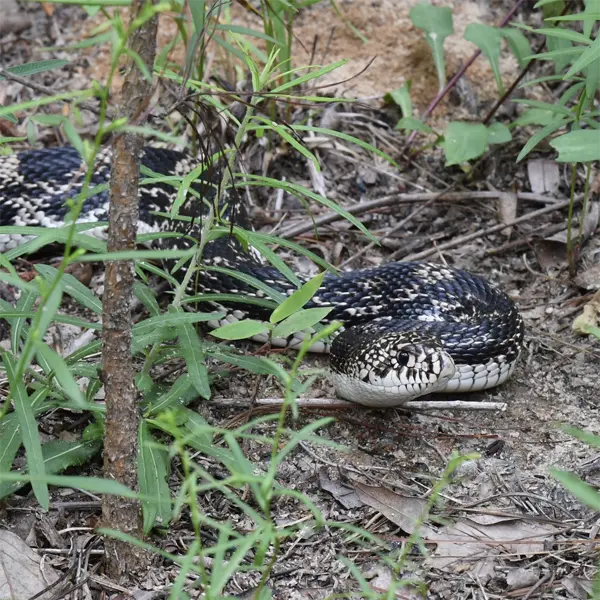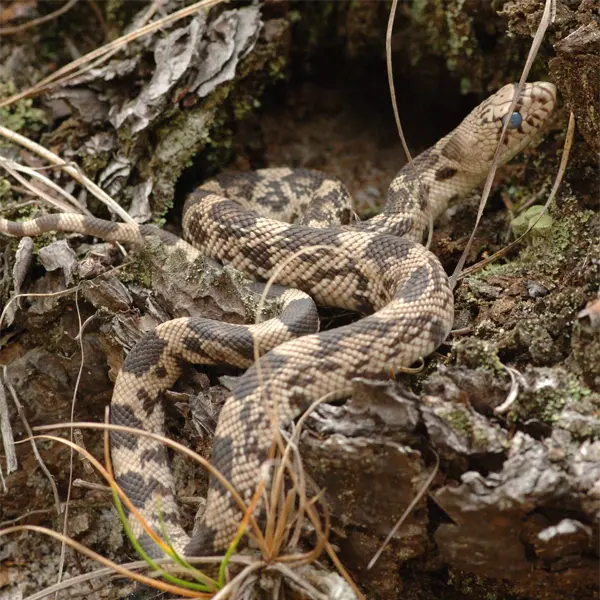Pinesnake
- Scientific Name
- Pituophis melanoleucus
- Also Known As
- Bullsnake, Eastern Pine Snake
- Range
- Most of Florida except in the South
- Diet
- Small Rodents, Rabbits, Possums, Birds
- Life Expectancy
- 15 Years
Quick Links
Pinesnakes in Central Florida
The eastern pinesnake (Pituophis melanoleucus) is a large, powerful constrictor endemic to the southeastern United States. Often confused with other colubrids, the eastern pinesnake is distinguished by its size, color pattern, and habitat. This comprehensive guide provides detailed identification tips, biology facts, and information about eastern pinesnakes in central Florida.
Read on to learn pinesnake habits, reproduction, diet, health risks, signs of activity, and professional removal options if encountered on your property.
Appearance and Identification
Eastern pinesnakes can be identified from other snakes by their physical characteristics at both juvenile and adult stages
The eastern pinesnake’s large size, distinct markings, and powerful build distinguish it from lookalikes like rat snakes and corn snakes. Identifying tracks, skin sheds, and behavioral signs also helps detect their presence.
Maturation Rate
Pinesnake growth rate depends on food availability and climate:
- Hatchlings double in size within the first year, reaching 2-3 feet (0.6-0.9 m) long.
- By age 2, pinesnakes achieve 3-4 feet (0.9-1.2 m) long.
- Full adult size averaging 4-6 feet (1.2-1.8 m) is attained by ages 3-5.
- Maximum length up to 7 feet (2.1 m) is reached by age 7-10.
Their rapid growth allows pinesnakes to readily consume larger prey as juveniles.
Habits and Behavior
Eastern pinesnakes are solitary, terrestrial snakes most active during the daytime. They prefer sandy pine and scrub oak habitats where they can burrow underground. Pinesnakes spend much of their time hidden beneath leaf litter or buried in soil for thermoregulation and protection.
When active, pinesnakes move in an undulating push-up motion with the head and neck raised. They are alert with keen senses of smell, vibration, and heat detection from the labial pits on their face. Pinesnakes can strike quickly and deliver a powerful bite when threatened. They rarely bite humans however unless severely provoked.
Pinesnakes are excellent climbers and readily ascend trees, logs, and poles. They are also strong swimmers capable of crossing rivers and streams. Home ranges are large, up to 200 acres (81 hectares) for males.
Reproduction and Lifespan
Eastern pinesnakes mate from April to May. Females lay clutches of 4-24 eggs in sandy burrows or under rotting logs from May to July. The eggs incubate for 60-80 days before hatching from August to October.
Hatchlings grow rapidly feeding on lizards, small rodents, and nestling birds. Maturity is reached in 2-3 years for males and 3-4 years for females. Lifespans in the wild average 15 years but can exceed 20 years.
Ideal Habitat and Range
Central Florida’s warm, humid climate provides excellent habitat for eastern pinesnakes. Average temperatures range from the 60s°F (15-20°C) in the north to the 70s°F (21-26°C) in the south with summer highs near 90°F (32°C). Rainfall averages 40-60 inches (1000-1500 mm) per year.
Pinesnakes thrive in the pine flatwoods, scrub oak, dry prairies, and mix of rural and suburban areas surrounding cities. The sandy soil allows them to burrow and conceal themselves while shrubs and pine trees provide cover. Nearby wetlands, forests, and farms support rodents and other prey. Rural buildings, debris piles, and abandoned burrows offer shelter.
The abundance of food, warm climate, and sandy habitat enables pinesnakes to flourish in central Florida. Their secretive nature keeps them hidden but substantial populations likely inhabit the region. Caution is advised when working outdoors given the possibility of encounters.
Diet and Feeding
Eastern pinesnakes are carnivores that consume a variety of warm-blooded prey:
- Small rodents – mice, voles, squirrels, rats.
- Rabbits and hares.
- Opossums.
- Ground-nesting birds – quail, turkeys.
- Reptiles – lizards, smaller snakes.
- Amphibians – frogs, salamanders.
They kill prey by constriction, suffocating the animal within minutes. Pinesnakes often hunt by lifting their head among dense brush watching for movement. Their heat pits also help detect hidden prey.
Food is swallowed whole and digestion is rapid taking 1-2 days. Pinesnakes can go weeks between large meals. They do not hesitate to enter homes and attack pets or livestock if accessible.

Photo 239795464 © arakso, CC BY-ND

Common Health Risks
Eastern pinesnakes pose minimal danger to humans and pets. They are non-venomous constrictors that rarely bite defensively. Pinesnake bites generally do not break skin and only cause minor abrasions.
However, potential health risks include:
- Bacterial infection – From contact with pinesnake oral bacteria. Manageable with proper wound care.
- Allergic reaction – Protein in snake saliva can potentially trigger anaphylaxis in sensitive individuals. Seek medical care if bitten.
- Fear and stress – Unexpected encounters or bites can result in anxiety, rapid heart rate, sweating, and elevated blood pressure.
Proper handling techniques like using snake hooks and tubes allow safe relocation of wayward pinesnakes without harm when encounters occur.
Preventing Pinesnake Encounters
The primary deterrents involve reducing habitat appeal and blocking access:
- Remove debris piles, leaf litter, and dense weeds where pinesnakes hide and hunt.
- Seal any openings wider than 1/4 inch in foundations and walls.
- Install wildlife-proof fencing at least 3 feet tall and 6 inches buried around gardens and poultry runs.
- Trim back vegetation near buildings to eliminate hiding spots and climbing access.
- Seal gaps around pipes, vents, and utilities leading into structures.
- Inspect lumber, debris, and materials stored outside that could provide shelter.
Making your property less suitable will encourage pinesnakes to avoid developed areas and dwell in their natural pine habitat.
Pinesnakes in Central Florida
Eastern pinesnakes are native apex predators that play an important role in the ecology of central Florida. They consume rodents and other small pests but prefer natural pine and scrub oak areas over neighborhoods. Pinesnakes should be appreciated from a distance and left alone if encountered.
With proper exclusion techniques, attacks on pets can be prevented without harming these docile snakes. Manage pinesnake issues promptly and humanely by contacting professional wildlife removal services when needed.







